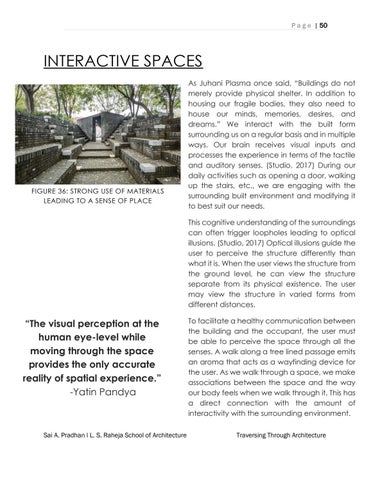P a g e | 50
INTERACTIVE SPACES
FIGURE 36: STRONG USE OF MATERIALS LEADING TO A SENSE OF PLACE
As Juhani Plasma once said, “Buildings do not merely provide physical shelter. In addition to housing our fragile bodies, they also need to house our minds, memories, desires, and dreams.” We interact with the built form surrounding us on a regular basis and in multiple ways. Our brain receives visual inputs and processes the experience in terms of the tactile and auditory senses. (Studio, 2017) During our daily activities such as opening a door, walking up the stairs, etc., we are engaging with the surrounding built environment and modifying it to best suit our needs. This cognitive understanding of the surroundings can often trigger loopholes leading to optical illusions. (Studio, 2017) Optical illusions guide the user to perceive the structure differently than what it is. When the user views the structure from the ground level, he can view the structure separate from its physical existence. The user may view the structure in varied forms from different distances.
“The visual perception at the human eye-level while moving through the space provides the only accurate reality of spatial experience.” -Yatin Pandya
Sai A. Pradhan l L. S. Raheja School of Architecture
To facilitate a healthy communication between the building and the occupant, the user must be able to perceive the space through all the senses. A walk along a tree lined passage emits an aroma that acts as a wayfinding device for the user. As we walk through a space, we make associations between the space and the way our body feels when we walk through it. This has a direct connection with the amount of interactivity with the surrounding environment. Traversing Through Architecture




















